
In today's rapidly evolving business landscape, leveraging Software as a Service (SaaS) solutions can be a game-changer for companies looking to scale and stay competitive. SaaS offers flexibility, scalability, and cost-efficiency, making it an attractive option for businesses of all sizes. Here are five effective strategies to drive company growth using SaaS solutions.
1. Streamline Operations with Integrated Platforms
Centralized Data Management
One of the key benefits of SaaS solutions is the ability to centralize data management. Integrated platforms allow businesses to streamline operations by connecting various departments and systems. This centralization enhances data accessibility and accuracy, leading to better decision-making and operational efficiency.
Automation of Routine Tasks
SaaS platforms often come with automation features that can handle repetitive tasks such as data entry, report generation, and customer follow-ups. By automating these tasks, companies can free up valuable time and resources, allowing employees to focus on more strategic activities.
2. Enhance Customer Experience
Personalization and Engagement
SaaS solutions, particularly in the realm of Customer Relationship Management (CRM), enable businesses to personalize customer interactions based on data insights. By understanding customer preferences and behavior, companies can deliver more tailored and engaging experiences, leading to higher satisfaction and loyalty.
Omni-Channel Support
Modern customers expect seamless support across multiple channels. SaaS solutions provide tools for omni-channel customer service, ensuring consistent and efficient support whether customers reach out via email, chat, social media, or phone. This enhances the overall customer experience and builds stronger relationships.
3. Boost Marketing Efforts with Data-Driven Insights
Advanced Analytics
SaaS marketing platforms offer advanced analytics capabilities that help businesses track and measure the performance of their marketing campaigns. These insights enable companies to identify what works and what doesn’t, allowing for continuous optimization of marketing strategies.
Targeted Campaigns
With access to detailed customer data and segmentation tools, businesses can create highly targeted marketing campaigns. SaaS solutions enable precise audience targeting based on demographics, behavior, and preferences, resulting in more effective and efficient marketing efforts.
4. Facilitate Remote Work and Collaboration
Cloud-Based Collaboration Tools
The rise of remote work has made cloud-based collaboration tools essential for maintaining productivity. SaaS solutions such as project management and communication platforms enable teams to collaborate in real-time, regardless of their location. This ensures that projects stay on track and team members remain connected.
Secure Access and Sharing
SaaS solutions provide secure access to company resources and data from anywhere. Features like multi-factor authentication and encrypted data transfer protect sensitive information, ensuring that remote work does not compromise security.
5. Scalability and Flexibility
Pay-As-You-Go Model
SaaS solutions often operate on a subscription basis, allowing businesses to scale their usage up or down based on their needs. This flexibility ensures that companies only pay for what they use, making SaaS a cost-effective solution for growing businesses.
Quick Deployment and Updates
Unlike traditional software, SaaS solutions can be quickly deployed and are regularly updated by the provider. This means businesses can rapidly adapt to changing market conditions and benefit from the latest features and improvements without the hassle of manual updates.
Conclusion
Implementing SaaS solutions can significantly drive company growth by streamlining operations, enhancing customer experience, boosting marketing efforts, facilitating remote work, and providing scalability. By leveraging these strategies, businesses can stay competitive, agile, and positioned for long-term success. Embracing SaaS is not just a technological upgrade; it’s a strategic move towards a more efficient and effective business model.




